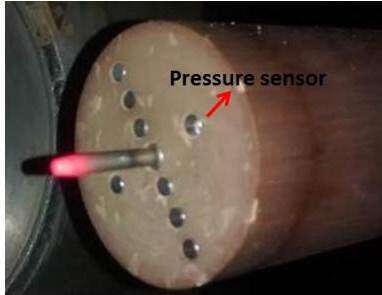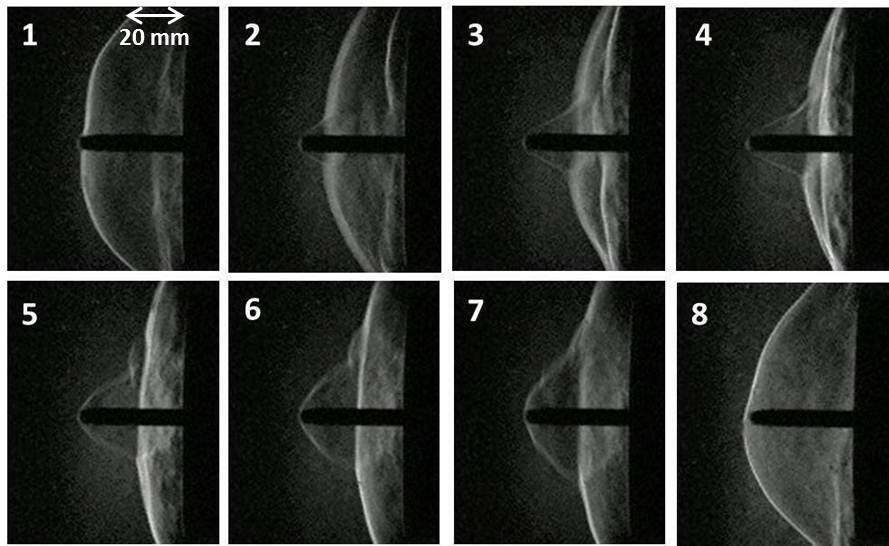Abstract:
Forward separation zones formed ahead of spiked blunt bodies facing hypersonic flows are unsteady in nature. This unsteady flow separation leads to pressure fluctuations of high amplitude and frequency. These fluctuations are caused by the mass imbalance between the amount of gas entering the separation zone and the amount of gas leaving it at the point of reattachment [1]. Earlier investigations [1-4] on the flowfield around spiked bodies have reported the occurrence of two distinct unsteady flow modes namely, oscillation and pulsation. Oscillation is typical of longer spikes (0.2 < L/D < 1.5) and is characterised by a small change in the size of the conical separated flow region. On the other hand, shorter spikes (1.5 < L/D < 2.5) exhibit the unsteady flow regime of second type, pulsation. Pulsation includes the formation of a separation zone at the spike, which grows in size and eventually collapses and the cycle continues with the formation of a new separation zone. Many wind tunnel studies [1-4] in the past have investigated the influence of geometric parameters such as the ratio of the length of the spike to the forebody diameter (L/D), diameter of the spike (d) and its tip angle (β), the inclination of the forebody nose to the axis of the spike (θ) and the relative forebody shoulder roundness (r/D) and flow parameters such as free-stream Mach number (M), Reynolds number (Re) and angle of attack (α) on the characteristics of the unsteady separation zone. Also, it is reported that with increase in the stagnation temperature (Tₒ) of the oncoming free-stream, the pulsation frequency increases [4]. However, the influence of stagnation temperature on the physical flow pattern of the unsteady separation region has not been studied systematically. Also the effect of external heat addition on the unsteady flow regime over axially symmetric spiked bodies is not well understood [3]. It is with this backdrop, a research program has been initiated at the Department of Aerospace Engineering, IISc to investigate the effect of external heat addition, free-stream stagnation temperature and hence enthalpy, which is characteristic of hypersonic flow on the pulsation frequency.
A flat faced cylinder with a forward facing spike of length L/D =0.45 is the test model (Fig.1). The spike used has a heating coil inside which provides uniform heating over the spike length during the test time. Fast response pressure transducers are placed radially at 1/4, 1/2 and 3/4 of the diameter on the flat end of the cylinder to record the pressure fluctuations. Preliminary experiments are carried out in the Hypersonic Shock Tunnel – 2 (HST-2) of IISc for a free-stream Mach number of 6 at zero angle of attack. The effective test time available for HST-2 is around 800 µs. The stagnation enthalpy of the flow is 1.3 MJ/kg. The flow is visualized using the schlieren photography and is recorded using a high speed camera at 100,000 frames per second with an exposure time of 9 µs.

Figure 1 : A photograph of the test model.(The spike with internally mounted heating coil emits light when heated.)

Figure 2 : Schlieren pictures of the flowfield showing different phases of pulsation.
Fig.2 shows the sequence of events in a cycle of pulsation (no heat addition). As the gas blows out of the collapsed separation zone, a normal shock wave starts moving downstream from the spike tip towards the nose initiating the cycle (Frames 1 and 2). As the shock travels along the spike, it becomes weaker and the flow behind it can acquire supersonic velocity. This causes a second shock to be formed in front of the forebody nose (Frames 3 and 4). When the moving spike tip shock merges with the second shock, a new stronger shock wave is formed. This triggers the boundary layer on the spike to separate and a nearly conical separation region is formed (Frames 5 and 6). The boundary layer separation or the separation shock is not visible in these pictures. This could be because the resolution of the frame is too low to capture the small flow features in great detail. As the gas continues to enter the separation region, it grows in size with its leading boundary spreading outwards away from the spike axis and eventually collapses with a single large bow wave enveloping the body-spike configuration (Frames 7 and 8). Following the destruction of the separation zone, the gas drains out initiating the start of a new cycle.

Figure 3 : Experimental pressure history recorded on the cylinder face at a diameter of 3D/4.
Fig.3 shows a typical pressure signal obtained from a sensor located at 0.75 D on the flat end of the cylinder. Four pressure peaks are recorded during the test time. The frequency of pulsation as measured from the experiment at Mach 6 and at stagnation enthalpy 1.3 MJ/kg is approximately 5500 Hz. These experiments also demonstrate that impulse ground test facilities like shock tunnels can be used to study unsteady phenomena of high frequencies.
Experiments on heat addition and computational studies are underway and the details will be presented in the full length paper.
References :
1) Mair WA. Experiments on separation of boundary layers on probes in front of blunt-nosed bodies in a supersonic air stream, Philosophy Magazine, Series 7, 1952;43(243):695–716.
2) Maull DJ. Hypersonic flow over axially symmetric spiked bodies, Journal of Fluid Mechanics 1960; 8(P.4):584–92.
3) Wood CJ. Hypersonic flow over spiked cones, Journal of Fluid Mechanics1961; 12(Pt. 4):614–24.
4) Antonov AN, Shalaev SP. Non-stationary separation on spiked bodies, Fluid Dynamics 1979; 14(1):71–6.

